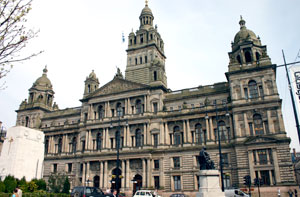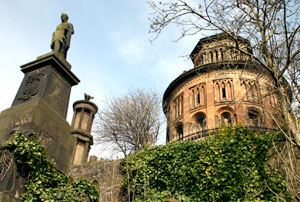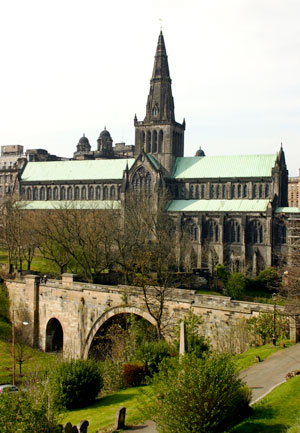GLASGOW, SCOTLAND - This is a city that doesn’t get as much attention as Scotland’s capital Edinburgh and Glaswegians are quick to point that out to visitors.
“Edinburgh is a fine city,” a man named Kenny tells me. “But Glasgow has even more to offer. It’s now one of the finest cities in Europe and it’s about time people come to realize that.”
Glasgow had a reputation as being a dock town with lots of bars occupied by blue collar roughens. But the city has worked hard to change that image over the past few years and was rewarded for its efforts by being named the European capital of culture in 1990.
It was a well deserved honor since this city is jam packed with culture and history. And it doesn’t take a visitor long to be introduced to Glasgow’s historic charms, most of which are found on compact streets lined with distinguished Victorian buildings.

Above: Glasgow's City Hall is an impressive structure.
The first building that caught this traveler’s eye was the ornate City Chamber (City Hall), a 100-year-old masterpiece that dominates statue-filled George Square in the heart of Glasgow.
A grand winding staircase held up by beautiful marble columns stands glowing in the natural light streaming through the building’s huge windows. The staircase leads to the glorious City Council chamber and a visit here is a great way to start a tour of Glasgow.
Glaswegians talk proudly about their city’s architecture and the one name that keeps coming up is Charles Rennie Mackintosh, the Art Nouveau pioneer who put Glasgow on the architectural map with his innovative designs.
Considered a maverick of his time, Mackintosh laid the foundation for what now is generally recognized as “Glasgow Style.” Between 1890 and 1912 he designed a collection of buildings combining traditional Scottish architecture with Japanese and Art Nouveau influences.

Above: Some historic figures are buried in Glasgow.
His most famous work is the beautiful Glasgow School of Art, recognized now as one of the most important buildings of the Modern movement in Europe. There’s even a Charles Rennie Mackintosh Trail visitors can follow.
Mackintosh was no doubt inspired by some of the city’s earlier deign masterpieces, a list topped by Glasgow Cathedral. The massive green roofed cathedral blackened by age and pollution, is the only one on the Scottish mainland to survive the Reformation of 1560 intact. Named St. Mungo after Glasgow’s patron saint, the cathedral is built on the site of his tomb. On an hill overlooking Cathedral Square is Glasgow’s famed necropolis, where some of Scotland’s greatest names are etched into massive monuments or simple headstones.
You cross the Bridge of Sighs to get to the cemetery, where you’ll sigh with delight with what you’ll see. A massive monument dedicated to John Knox, the famed Scottish Reformer, dominates the cemetery which was modeled after Paris’ historic Pére-Lachaise.
There are over 3,500 tombs in the cemetery and more than 50,000 people have been buried there. The necropolis gives visitors a great insight into the history of Glasgow. Across the street from the cathedral, on Castle St., is the former Bishop’s Hospital, erected in 1471, which holds the distinction of being Glasgow’s oldest building.

Above: Glasgow cathedral is city's oldest building.
The buildings that make up Strathclyde University are more eye candy that are sweet treats to visit. More than 100,000 students attend Glasgow’s two main universities and the young learners give the city a youthful enthusiasm that reminded this visitor of Dublin.
Glasgow University, with its own amazing architecture, boasts the largest school population – over 30,000 – and the area around the ancient university offers some of the best nightlife in town.
One of the more fascinating places in Glasgow is Nelson Mandela Place, a small area off the city’s main shopping street that was renamed in honor of the South African leader and his fight against Apartheid.
Sauchiehall St. and the area around it offers visitors lots of traditional shops and restaurants and has its fare share of high end designer stores.
Modern Glasgow is on display at Clydeside, an area bordering the River Clyde which was once home to the city’s renowned docks. The area has been spruced up with a collection of modern buildings, including the Clyde Auditorium, which looks suspiciously like Sydney’s famous Opera House.
Glasgow also has its own thriving arts scene that rivals anything else in Europe, and its eating establishments – we highly recommend Oshi at Langs Hotel or Stravaigin near Glasgow University – are some of the best anywhere. This city is also renowned for its Italian eateries, from simple pizza parlors to gourmet establishments.
Many Italians were brought to Glasgow as prisoners during World War II and when the war ended, they stayed on. It seems no one wants to leave Glasgow once they’ve been here.
Information
- Langs Hotel is located at 2 Port Dundas Place, next to Glasgow’s main bus station and within walking distance of the main railway station. For information, go to www.langshotels.co.uk
- The Stravaigin restaurant is located at 28 Gibson St. You’ll need reservations to get into this popular downstairs eatery. Call 0141 334 2665 or go to www.stravaigin.com
- Most museums and historic sites are free in Glasgow.
- Glasgow is a great place to base yourself when visiting Scotland. There’s regular train service between Glasgow and arch-rival Edinburgh – trains leave every 20 minutes from Queen Street Station.
- For more information on Glasgow, go to www.seeglasgow.com.
- For information on Scotland, go to www.visitscotland.com.
- There are several pedestrian shopping malls in the city centre.
- Glasgow has a subway that offers a cheap way to get around the city.
About the Author
Marc Atchison is a veteran journalist and a seasoned traveller with more than 20 years of travel writing experience. As the former Travel Editor of the Toronto Star, Canada's largest newspaper, and now Editor-in-Chief and Senior Writer for TraveLife magazine (Canada) and travelife.ca, Marc has been to over 100 countries in the world. Japan is one of his favorite destinations and he's been there on numerous occasions.